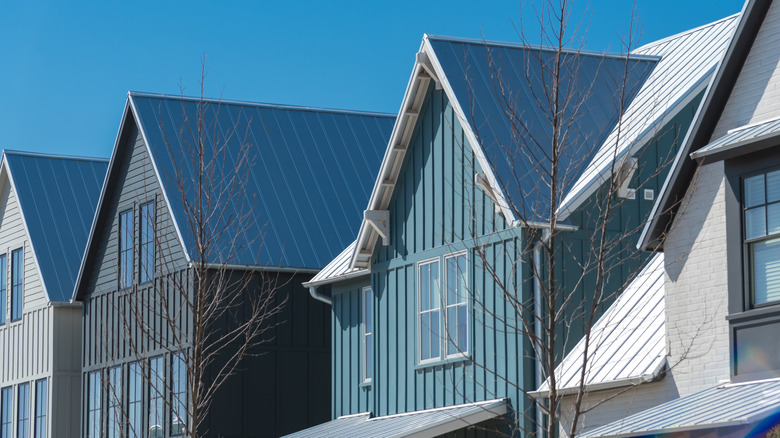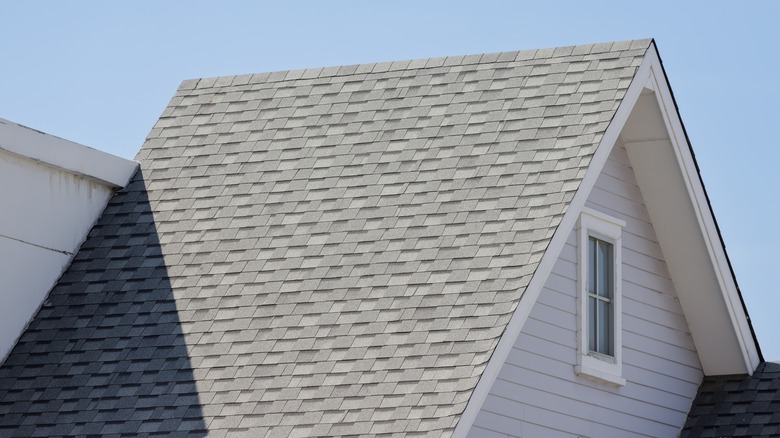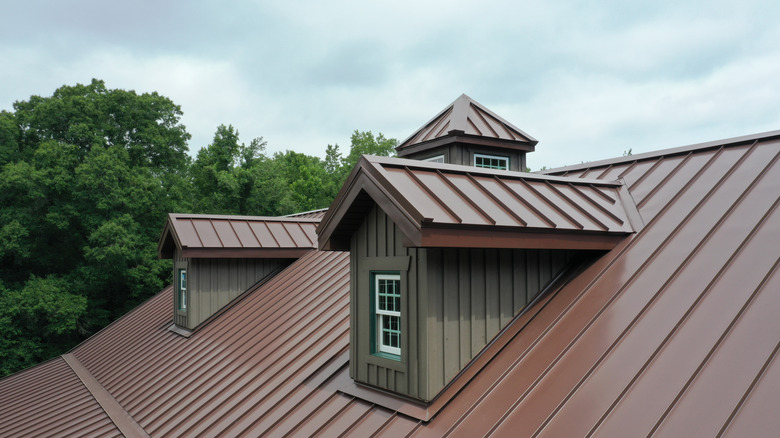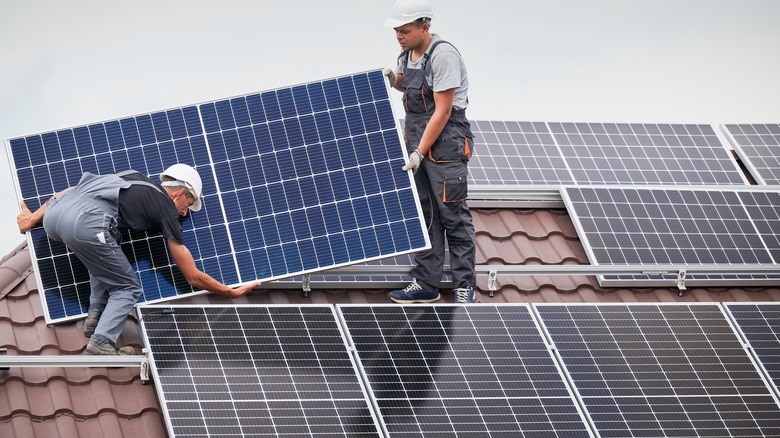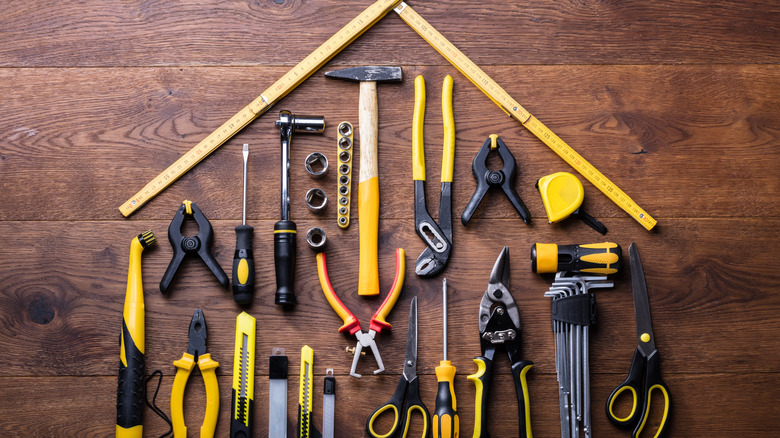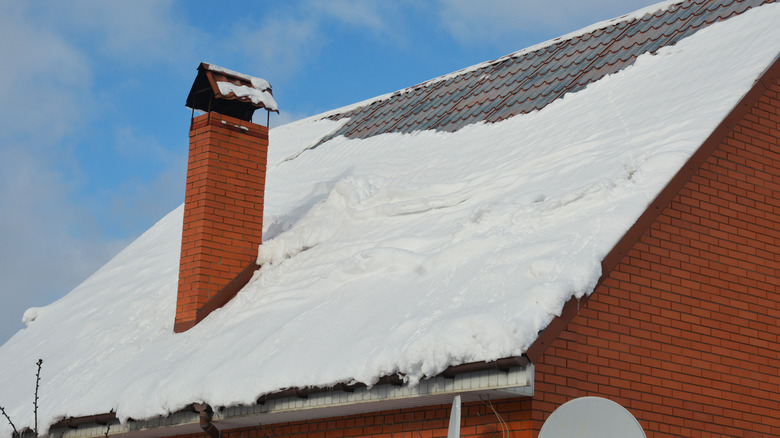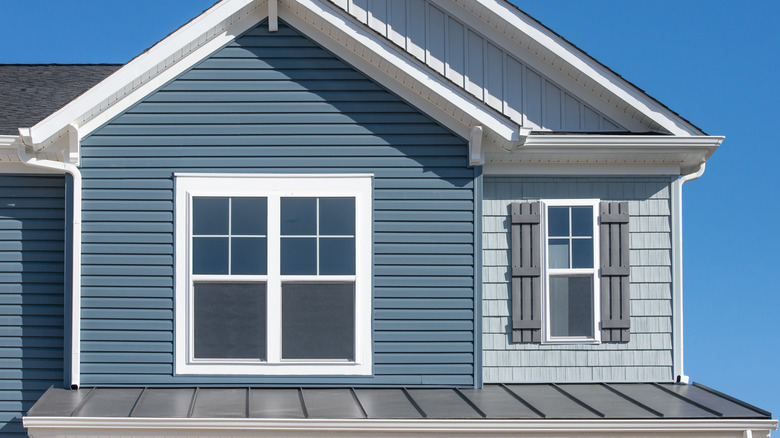Metal Roof Vs. Asphalt Shingles: What's The Difference?
Roofing might seem an unglamorous thing to pay attention to, but it's a crucial part of ensuring your home's longevity and value. One of the first things buyers ask at viewings is, "how's the roof?" Choosing a suitable roofing material is one of the biggest decisions you can make for your home. So what are the top options available?
Metal roofing is a common choice for many who live in places with harsher weather conditions, as it's proven to be durable against even the heaviest rainfall (via Sheffield Metals). The other option — arguably the most popular with homeowners — are asphalt roof shingles. Identified by their overlapping design, these shingles have become the most popular roofing material, perhaps thanks to their affordability (via Roofing Lines). So what are the actual differences between these two roofing options? It's not just the aesthetics that vary. They also differ in energy use, real estate value, and safety. Let's take a look.
How does the composition differ?
There are five common metal roofing materials to choose from: steel, aluminum, copper, zinc, and tin. Of these five, steel and aluminum are the most commonly used in residences, as materials like zinc cost a pretty penny, per Metal Panels Inc.
Steel, an iron alloy, has three variations: galvanized, galvalume, and weathering steels. Galvanized refers to the coating of zinc over steel to protect it from erosion (via Bridger Steel). Galvalume, on the other hand, combines zinc, aluminum, and silicone as a layer over steel to protect it from oxidation. On the other hand, weathering steel, as the name implies, intentionally exposes an outer layer of steel to the elements to create a layer of rust. This layer protects the inner steel from the same fate.
Regarding shingles, asphalt is the primary option for residential buildings (via CertainTeed). Its components include fiberglass, asphalt, and mineral granules, also referred to as composite shingles. There are up to 16 types of asphalt shingles, including 3-Tab shingles, architectural shingles, luxury shingles, and strip shingles (the most common.) These asphalt shingles come in a variety of colors, which makes them an attractive choice for homeowners.
Is steel safer than asphalt?
When it comes to the battle between steel and asphalt, the two primary roofing materials used on residential builds, the question of which is safer often comes up. But let's explore why. When it comes to steel, one of the significant advantages is its durability in extreme and increasingly unpredictable weather conditions. Metal roofing is generally said to withstand up to 150mph of wind — similar to a Category 4 hurricane or F2 tornado (via ATAS International). If you live in a hurricane or tornado-prone area, you have the best chance for protection with a metal roof. Asphalt shingles, unfortunately, do not have the same durability in these conditions and will begin to lift over time causing further damage to the structure underneath.
However, these two roofing options fare well under UV exposure and highly resist fire, but as we will continue to discover, while they have similarities, these materials are different. Asphalt can resist fire for as long as two hours before catching (via Cedur). However, steel's non-corrosive nature means it can last up to two to four hours before it catches.
In addition to concerns about the weather, roof shingles pose a minor toxic threat to builders and DIY-ers during installation and removal, thanks to the large amount of dust and sealants present. Though not as common these days, some shingles were made with asbestos — a carcinogenic mineral made up of microscopic fibers – which can create serious health issues in the long run (via Basey's Roofing).
What are the differences in cost?
One of the advantages of asphalt shingles that makes them so popular with residential builds is that they cost less than many other materials on the market, including steel. According to Forbes, metal roofing can cost anywhere from $5,000 to $15,000, depending on the home's square footage. More specifically, steel sheets start at $150 per square for galvanized steel and $75 per square for galvalume steel. Each square footage is made up of 100 square feet.
For asphalt shingles, homeowners can expect to pay anywhere between $5,000 and $12,000, making it, on average, a more affordable option. These shingles usually cost around $90 per square foot (via Forbes).
Around 60% of the cost for both materials will be attributed to labor. Additionally, with both roofing systems, the pitch of your roof, which refers to the roof's steepness, can further sway the cost of either asphalt shingles or metal sheets.
What are the differences in energy use?
As the world is taking notice of climate change and exploring all the ways to be more eco-friendly, many homeowners might wonder how to make their homes more energy efficient. As a first point of defense between the house and the sun, the roof takes on a lot of heat.
Asphalt shingles retain that heat, which can seep into the interior of the building, thereby increasing the temperature by over 20 degrees (via Florida Solar Energy Center). Meanwhile, metal roofings reflect the solar heat, keeping the home cool (via Metal Roofing Alliance). Metal roofing is so energy efficient it can save you up to 40% on your energy bills. But asphalt shingles, though not excellent at reflecting heat, can be built to be more energy efficient, thanks to the introduction of solar-reflecting granules that limit heat absorption (via Roofsimple).
How easy is each to DIY?
Turning a roof replacement into a do-it-yourself project is a great cost-saver, but opting to DIY a roof — whether with metal sheets or asphalt shingles — takes some prior experience. It may require you to do some studying before you begin.
Asphalt shingles make the DIY task easier to undertake thanks to a reasonably straightforward execution using a hammer, a hooked knife, and a folding ruler as your primary tools. You fit the shingles together like puzzle pieces and nail them down. While it is also possible to lay metal sheets yourself, this is a decidedly more technical exercise (via Gouge Quality Roofing). You'll need to roll out your roof underlayment, install the edging, calculate a square reference line to install the panels evenly, cut the panels to size, and once you overlap them, screw them in tightly, so the roof stays waterproof. Knowing what you are doing and the best way to do it before you begin is essential with both types of roofing systems.
How do they differ in real estate value?
According to the annual Remodelling Impact Report for 2022, metal roofing has an ROI of 54%. At the same time, asphalt shingles had a 59.6% ROI on a national scale. The report showed that, regionally, asphalt shingles had the highest percentage retail value in the Pacific region, where it scored its home retail value at 69.4%, and lowest in the West North Central, where it was set at 50.3%. Similarly, metal roofing saw its highest contribution to real estate value in the Pacific region with 60% and its lowest in the West North Central region, where its percentage value was 48.3.
While it is likely that a roof replacement will add value to your home — with asphalt shingles being the higher value percentage — it is also likely that the cost of the replacement will outweigh any added value (via Credit Karma). Asphalt shingles need to be replaced more frequently than metal roofing.
When to choose steel over asphalt (and vice versa)
As design trends evolve, so too do the methods of roofing applications. With roof slopes getting steeper, certain roofing styles have become more of a challenge to execute in traditional ways. One of the critical things to consider is the roof pitch, that is, the roof's steepness. Asphalt shingles should only be installed if the steepness is 45 degrees. In that instance, one may opt for a steel roof instead.
The limitations of asphalt roofing on specific roof designs — no steeper than 45 degrees but no flatter than 15 – means that metal roofing options are arguably more versatile (via RJ Evans Flat Roofing). Asphalt shingles might retain rainfall, which can eventually leak into the home and cause damage to the roof, but specific installation methods allow the metal roofing system to properly expel rainwater, even at a steep angle (via Sheffield Metals).
How does the appearance differ?
Both metal and shingle roofing systems offer various aesthetic options, from colorways to design, but they have distinct appearances. In general, metal roofs look sleek and modern thanks to their reflective nature, giant panels, and robust color options. Shingles look more traditional, and look like a series of small squares from far away. There are different styles of metal roofing, the most popular of which is the standing seam. With this style, large metal sheets are placed vertically along the length of the roof. Stylish and durable, this is a popular choice for metal roofing since the design is virtually leak-proof (via JTC Roofing Contractors).
The 3-Tab, luxury, and dimensional shingles are three popular styles for asphalt roof shingles. At the same time, the 3-tab is simple in its design, which resembles a bricklaying pattern. As the name suggests, the luxury asphalt shingles offer a more premium look to your roof — often compared to slate tiles. Finally, the dimensional shingles are made up of two layers of shingles and resemble wood shakes (via Total Home Roofing).
